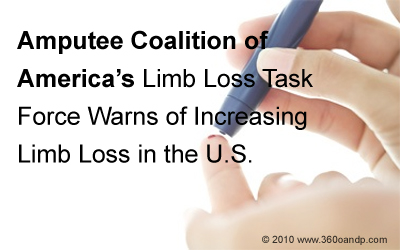
Amputee Coalition of America’s Limb Loss Task Force Warns of Increasing Limb Loss in the U.S.
Most at Risk Are Minorities and People With Diabetes and Vascular Disease
Knoxville, TN, April 28, 2010 – On average, 507 people lose a limb every day in the United States. This number is expected to almost double by 2050 unless a major public awareness campaign is launched and key prevention initiatives put in place, according to an expert task force convened by the Amputee Coalition of America. The Limb Loss Task Force met in Washington, D.C. on April 16-18 to develop a series of recommendations that will serve as the roadmap to limb loss prevention and improved care for amputees across the country.
The Task Force reviewed in-depth facts and figures that demonstrate the urgency for a strategic approach to limb loss prevention and improved amputee care such as:
• 185,000 amputations occur each year.
• 60 percent of all amputations are preventable.
• Diabetes and vascular disease are the leading causes of limb loss and major drivers of increased limb loss incidence in the U.S.
• Leg amputations alone account for more than $250 million each year in healthcare costs.
• 75 percent of acquired pediatric amputations are from trauma – most notable is that, on average, 600 children lose a limb due to a lawnmower accident each year.
• Minorities are at higher risk for limb loss – African Americans are four times more likely to lose a lower limb than Caucasians of similar age and gender.
• As you age, your risk increases for limb loss, especially if you are an African American over the age of 35.
• Amputee care is not consistent throughout the U.S. Studies show inpatient rehabilitation care following amputation significantly reduces re-amputation and mortality, but not all healthcare systems include inpatient rehab care for amputees.
“No comprehensive or integrated plan exists on the national or state level that reflects amputee care within the civilian population – no mechanism for limb loss prevention advancement, cost reduction, or care improvement for people affected by limb loss,” said Kendra Calhoun, president and CEO of the Amputee Coalition of America. “In convening this expert task force, our board of directors is taking initiative to create a plan that will have a powerful impact on resolving these issues in the next decade.”
The task force, consisting of experts in limb loss – physicians, podiatrists, nurses, physical therapists, prosthetists, health behavior experts, and researchers from the private and public sectors, the military and the federal government – recommended a four-point action plan.
Amputee Coalition of America’s Four-Point Action Plan
• Implement a Blueprint for Limb Loss Prevention
• Host a Consensus Conference to define national optimal care guidelines for amputees
• Develop a national research agenda on limb loss prevention and amputation care
• Create a model for amputee rehabilitation/community reintegration and early limb loss prevention to be implemented in hospitals and clinics around the country.
“We applaud the task force’s decision to support a comprehensive four-point plan. This is the right direction, and we are confident the support of the task force combined with our organization’s execution of the four-point plan, will provide a powerful impact in the fight against limb loss and the pursuit of improved amputee care,” said Terrence P. Sheehan, MD, Amputee Coalition of America’s medical director and chief medical officer of the Adventist Rehab Hospital of Maryland. “Keeping Americans healthy and living to their full potential are our primary goals.” Dr. Sheehan cited key early intervention strategies to be included in the national discussions about diabetes, obesity and smoking cessation across the life span from teens to elders.
“We need people to understand that limb loss can happen to them,” said Dr. Sheehan. “Having limb loss included with stroke and heart disease as a consequence of smoking and obesity is key in raising public awareness and including this risk in care pathways for people with diabetes and peripheral arterial disease is crucial.” The Limb Loss Task Force also stressed the importance of more research on limb loss prevention and on living with limb loss.
“The current incidence numbers are alarming, especially for the most vulnerable, our minority populations (African Americans, Hispanic/Latino Americans, American Indians), in the United States caught in this healthcare disparity. We can no longer take a passive role to implementing a successful “team approach” to support the amputee patient and the patient’s family,” said Dr. Sheehan. “A major topic of the task force’s discussion was the inclusion of the amputee’s family on the care team. We see the positive outcomes with our military combat amputees and those amputees whose care systems include family members, but we need to make this approach the norm, not the exception.”
The Limb Loss Task Force recommendations will be forwarded to the Amputee Coalition of America’s Board of Directors for discussion at their June meeting.
“The Amputee Coalition of America is pleased to convene this summit of experts in their fields. We thank Dr. Sheehan as well as Dr. Stephen Wegener, associate professor and director of rehabilitation psychology of Johns Hopkins University, for their leadership of this key initiative and look forward to continuing the work of the task force,” said Calhoun.
About the Amputee Coalition of America
The Amputee Coalition, based in Knoxville, Tennessee, is a national nonprofit organization whose mission is “to reach out to and empower people affected by limb loss to achieve their full potential through education, support and advocacy, and to promote limb loss prevention.” For more information about limb loss, please visit the Amputee Coalition Web site at amputee-coalition.org or call 888/267-5669.